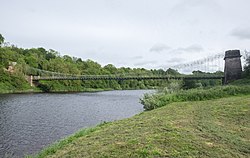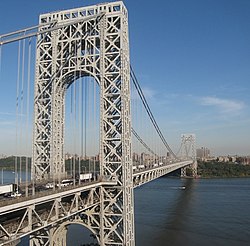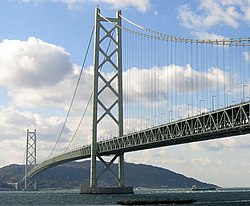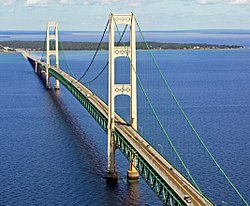| Photo | Bridge | Location | Length
m (ft) | Years of
longest span | Notes |
|---|

Hypothesized support | Maya Bridge at Yaxchilan |  Mexico Mexico | 62 m (203 ft) | 600–1430 | Hemp-rope simple suspension footbridge. Existence unproven. No longer standing. Prior longest bridges are located in List of longest arch bridge spans. Exceeded by the masonry arch Trezzo sull'Adda Bridge from 1377 to 1416, with main span of 72 m. |
 | Chushul Chakzam |  China China
Tibet | 137 m (449 ft) | 1430–1820 | Chain suspension footbridge south of Lhasa, built by Thangtong Gyalpo. Reported by British spies to still be in use in 1878. Later (before 1904) fell into disuse after river course changed, swamping the northern end. [89] Dynamited by Chinese soldiers after the Battle of Chamdo in 1950. [90] |
 | Union Chain Bridge |  United Kingdom United Kingdom
Scotland–England | 137 m (449 ft) | 1820–1826 | The oldest in the world still in use today. |
 | Menai Suspension Bridge |  United Kingdom United Kingdom
Wales | 176 m (577 ft) | 1826–1834 | |
 | Great Suspension Bridge |  Switzerland Switzerland
Fribourg | 271 m (889 ft) | 1834–1849 | The bridge was replaced by the Zähringen Bridge [ de ] in the 1920s. |
 | Wheeling Suspension Bridge |  United States United States
West Virginia | 308 m (1,010 ft) | 1849–1866 | The longest deck span from 1849 until 1866, and the oldest vehicular suspension bridge in use in the United States until 2019. |
 | Queenston-Lewiston Bridge |  United States United States
 Canada Canada | 317 m (1,040 ft) | 1851–1866 | The longest cable span from 1851 until it was destroyed by wind in 1864. However, the road deck span was only 258 meters long. |
 | John A. Roebling Suspension Bridge |  United States United States
Kentucky–Ohio | 322 m (1,056 ft) | 1866–1869 | |
 | Niagara Clifton Bridge |  United States United States
 Canada Canada | 384 m (1,260 ft) | 1869–1883 | Replaced in 1899. |
 | Brooklyn Bridge |  United States United States
New York City | 486 m (1,594 ft) | 1883–1903 | |
 | Williamsburg Bridge |  United States United States
New York City | 488 m (1,601 ft) | 1903–1924 | It was the longest suspension span but not the longest span of all bridges. The Forth Bridge, completed in 1890, a cantilever bridge with two spans of 521 m was longer until surpassed by the Quebec Bridge in 1917. |
 | Bear Mountain Bridge |  United States United States
New York | 497 m (1,631 ft) | 1924–1926 | It was the longest suspension span but not the longest span of all bridges. The Quebec Bridge completed in 1917, a cantilever bridge with a span of 549 m was longer until surpassed in 1929 by the Ambassador Bridge. The first suspension bridge to have a concrete deck. The construction methods pioneered in building it would make possible several much larger projects to follow. |
 | Benjamin Franklin Bridge |  United States United States
Pennsylvania–New Jersey | 533 m (1,749 ft) | 1926–1929 | It was the longest suspension span but not the longest span of all bridges. |
 | Ambassador Bridge |  United States United States
 Canada Canada | 564 m (1,850 ft) | 1929–1931 | Since this bridge was built, the record for longest bridge span has only been held by suspension bridges. |
 | George Washington Bridge |  United States United States
New York – New Jersey | 1,067 m (3,501 ft) | 1931–1937 | The first span longer than 1 km. Nearly double the length of any previously built bridge at the time of its opening. |
 | Golden Gate Bridge |  United States United States
California | 1,280 m (4,200 ft) | 1937–1964 | Also the longest bridge span in the world from 1937 to 1964 |
 | Verrazzano–Narrows Bridge |  United States United States
New York City | 1,298 m (4,259 ft) | 1964–1981 | Also the longest bridge span in the world from 1964 to 1981 |
 | Humber Bridge |  UK UK
Yorkshire | 1,410 m (4,630 ft) | 1981–1998 | Also the longest bridge span in the world from 1981 to 1998 |
 | Akashi Kaikyo Bridge |  Japan Japan | 1,991 m (6,532 ft) | 1998–2022 | Also the longest bridge span in the world from 1998 to 2022. The largest ever increase in length. |
 | Çanakkale 1915 Bridge |  Turkey Turkey | 2,023 m (6,637 ft) | 2022–Present | The longest bridge span in the world since 2022. The first span longer than 2 km. |




















































































